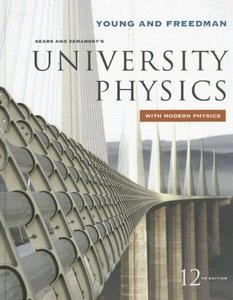Organization:University Physics
From HandWiki
 12th edition cover featuring the Millau Viaduct. | |
| Author | Hugh Young, Roger Freedman, Francis Sears, Mark Zemansky |
|---|---|
| Cover artist | Yvo Riezebos Design |
| Country | United States |
| Language | English |
| Genre | Physics |
| Publisher | Pearson Education |
Publication date | 1949 |
| Media type | Print (hardback & paperback) |
| Pages | 1632 pp (14th edition, hardcover)[1] |
| ISBN | ISBN:978-0-321-50062-5 |
University Physics is the name of a two-volume physics textbook written by Hugh Young and Roger Freedman. The first edition of University Physics was published by Mark Zemansky and Francis Sears in 1949.[2] Hugh Young became a coauthor with Sears and Zemansky in 1973. Now in its 15th edition, University Physics is among the most widely used introductory textbooks in the world.[3]
University Physics by Pearson is not to be confused with a free textbook by the same name, available from OpenStax[4]
Contents
Volume 1. Classic mechanics, Waves/acoustics, and Thermodynamics
- Mechanics
- Units, Physical Quantities, and Vectors
- Motion Along a Straight Line
- Motion in Two or Three Dimensions
- Newton's Laws of Motion
- Applying Newton’s Laws
- Work and Kinetic Energy
- Potential Energy and Energy Conservation
- Momentum, Impulse, and Collisions
- Rotation of Rigid Bodies
- Dynamics of Rotational Motion
- Equilibrium and Elasticity
- Fluid Mechanics
- Gravitation
- Periodic Motion
- Waves/Acoustics
- Mechanical Waves
- Sound and Hearing
- Thermodynamics
- Temperature and Heat
- Thermal Properties of Matter
- The First Law of Thermodynamics
- The Second Law of Thermodynamics
Volume 2. Electromagnetism, optics, and modern physics
- Electromagnetism
- Electric Charge and Electric Field
- Gauss’s Law
- Electric Potential
- Capacitance and Dielectrics
- Current, Resistance, and Electromotive Force
- Direct-Current Circuits
- Magnetic Field and Magnetic Forces
- Sources of Magnetic Field
- Electromagnetic Induction
- Inductance
- Alternating Current
- Electromagnetic Waves
- Optics
- The Nature and Propagation of Light
- Geometric Optics
- Interference
- Diffraction
- Modern Physics
- Relativity
- Photons: Light Waves Behaving as Particles
- Particles Behaving as Waves
- Quantum Mechanics
- Atomic Structure
- Molecules and Condensed Matter
- Nuclear Physics
- Particle Physics and Cosmology
References
- ↑ "University Physics". Amazon. https://www.amazon.com/University-Physics-Modern-MasteringPhysics-Package/dp/0321982584/ref=dp_ob_title_bk.
- ↑ "University Physics". Pearson Australia. http://www.pearson.com.au/student/university/product-listing-page/product-details-page/?isbn=9781442517110.
- ↑ "About Hugh D. Young". https://www.cmu.edu/mcs/fac_staff/handbook/YoungBio.html.
- ↑ Ling, Samuel. "University Physics". https://cnx.org/contents/1Q9uMg_a@9.185:Gofkr9Oy@15/Preface.

